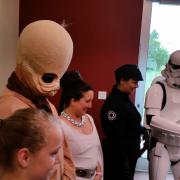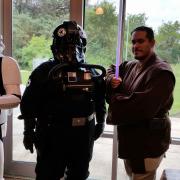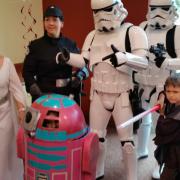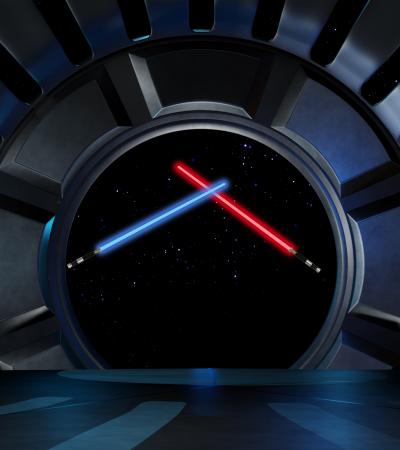Star Wars Day, an annual celebration of the famous franchise, offers games and crafts for children, a discussion for adults, and a movie for everyone.
Advanced Planning
I chose Star Wars Day as a way to bring people of all ages together for an afternoon of entertainment. Having previously held a successful Star Wars Day in another city, I expected to draw 100 people, many of them first-timers in our library; I also expected that the event would encourage circulation of the nearly 400 related titles in our collection. The event surpassed expectations, drawing 150 and emptying our display shelves of anything Star Wars, from board books to biographies.
Planning began a year in advance, as I searched the internet and book jackets for prospective presenters. I wanted an author of adult-level books to give a talk and fan club members to assist with children’s games and crafts. With a list of possible partners, I drew up a program outline and projected budget, then sought approval from my branch manager to hold the event and from our Friends group to fund it.
After gaining approval from both, I contacted hoped-for program presenters. Drew Karpyshyn, developer of the online game The Old Republic and author of several Star Wars novels, including those featuring the character Darth Bane, signed on to give a talk about his books and his experiences in the publishing industry. I asked a local bookstore to sell Karpyshyn’s books during the event. The animated TV series "Clone Wars," which was covered by our movie license, would provide additional entertainment for little ones.
Karpyshyn’s involvement, as well as that of Igo’s teen services librarian (a member of the Sith Shadow Council), attracted members of four Star Wars fan clubs to participate. I then worked with them to develop plans for the activities they would offer during the event. It was important to me that the fan club leaders felt they were equal partners in planning activities. The mission of these clubs, in addition to supporting their fandom, is charitable work, such as visiting children in hospitals and shelters. With their years of experience, they already have a tried-and-true repertoire of child-friendly activities. They brought in ideas for crafts and games.
At this stage I was able to draw up a schedule of activities. I had two adjacent meeting rooms in which to hold events, so I designated Room A for Karpyshyn’s talk and book signing, while Room B became the “noisy room.” A conference room became the changing room for the fan club members to get into costume.
- 2 to 2:30 p.m.: Costume parade. Participants of all ages were invited to wear Star Wars costumes. “Queen Amidala” of the Star Wars Society of San Antonio would lead the parade around the library.
- 2:30 to 4 p.m., Room A: Drew Karpyshyn’s talk and book signing
- 2:30 to 4 p.m., Room B: Craft-making, with assistance from the fan clubs; viewing of "Clone Wars"; photo ops with costume characters from the fan clubs, and light saber duels, instructed by the Rebel Legion. Treats.
The crafts we developed included C3PO and Vader masks, Leia and Yoda paper bag puppets, pool-noodle light sabers and Peeps Wars dioramas (Star Wars characters made out of Peeps candy). On the walls I had party decorations and a “Who’s Your Favorite Sith?” display that invited participants to vote by marking the photo of their favorite dark lord.
Marketing efforts began a month before the event. At this time I also purchased materials for the crafts and asked volunteers to cut out the pieces for children to color and assemble during the event. A week before the event, ingredients for treats (Yoda soda, light saber pretzels and popcorn) were purchased.
Marketing
With the main players on board, it was time to promote the event. SAPL’s marketing department sent press releases to the local media and posted announcements on Twitter and Facebook. A series of “teaser” LCD display cards (such as “Before Vader, there was Bane. Star Wars Day May 16”) was created, with a different card posted each week in the month leading up to the event. A display encouraged circulation of relevant books and movies; the display featured take-aways with word-finds, coloring pages, simple crosswords for children and more difficult crosswords for adults. Each take-away was labeled with information about the event.
Budgeting
Our author's travel expenses were covered by $130. Another $70 covered ingredients for treats and supplies for crafts. For our second Star Wars Day, a year later, we cut costs by reusing materials and showing the movie "The Force Awakens" as our primary entertainment, instead of bringing in an author. In 2015, we spent $200, and in 2016 we spent $146.
Day-of-event Activity
Set-up took two staff members three hours. In addition to setting up the projector, tables and chairs in the two meeting rooms, we put up decorations and set up a separate station for each craft. At our refreshments table, we posted signage for the recipes for our Yoda soda and light saber pretzels. Clean-up took the two staff members another two hours.
Promptness, we discovered, can be an issue when working with fan clubs. Most of the members arrived on time, but we had some latecomers, resulting in the need to improvise in assigning tasks. I left most of this coordination to the club presidents, since they know their people best. Although we had three rooms to work with, during the event, space became an issue. We also ran out of Yoda soda. The children found the Peeps Wars diorama activity too complicated, so for our 2016 Star Wars Day, I dropped it.
Program Execution
Our goals were surpassed: 150 people of all ages attended the event. The youngest was a 4-year-old dressed in a pink R2D2 costume that her parents had made. We had children running in and out throughout the two-hour event and quite a few adults who dropped in just to see why all these people were wearing costumes. One of our simplest activities proved to be the most popular: pose for a photo with Darth Vader.
Advice
I’ve had the pleasure of working with fan clubs to develop library programs for 15 years now, and although each club is different, I’ve learned some lessons.
- Know their mission. Along with promoting their fandom, fan clubs are usually deeply involved in charitable work, whether it’s by offering performances or by raising money. If your event will help them achieve both missions, you’ll have a better chance of securing their involvement.
- Show them you take them seriously. Before you approach them, learn what fans value about their particular fandom. Watch some of the movies/episodes. Learn the names of main characters, actors and writers. Learn some of the terminology. Show respect as you talk to the fans; be aware that many of them are well educated, community-minded individuals who work very hard to make their costumes. Authenticity is important to them, as is making children happy. And be aware that some may be active in other fandoms as well; these connections can lead you to ideas for additional programs.
- Gain some understanding of the relationship between competing fandoms (for example, Star Trek vs. Star Wars) and multiple clubs in the same fandom. (There may be rivalry between clubs, even though they support the same fandom.)
- Involve them in planning. Ask what sorts of activities they usually do in their outreach; let them tell you what works and what supplies are needed. But be aware that sometimes they will need nudging to stay on schedule and work within library rules.
- Be flexible with scheduling. Ask them when would be the best time to hold your event. Don’t conflict with the major events in their fandom (Comic Con, for instance).
- Provide them with water and snacks during the event.
- Write a thank-you note when it’s over. Share your stats, evaluations and pictures.
Supporting Materials
- Feedback (Coming Soon!)
- Programming Librarian Facebook Group






